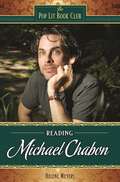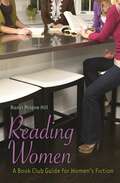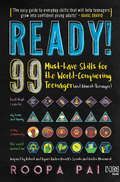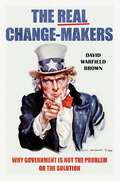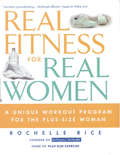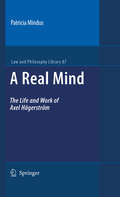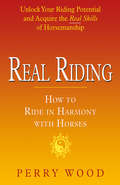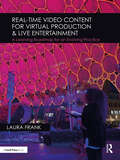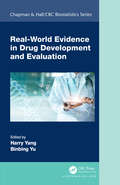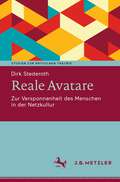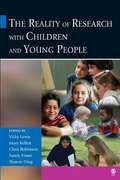- Table View
- List View
Reading Bion (New Library of Psychoanalysis Teaching Series)
by Rudi VermoteWilfred R. Bion is considered a ground-breaking psychoanalyst. His thinking is rooted in Freud and Klein from where it takes an original flight. Reading Bion shows the evolution of his seminal insights in psychic functioning and puts them in a wider context. Rudi Vermote integrates a chronological close reading and discussion of Bion’s texts, with a comprehensive approach of his major concepts. The book is divided in two main parts: Transformation in Knowledge: Bion’s odyssey to understand psychic processing or the mind Transformation in O: in which Bion reinterprets his former concepts from the dimension of the unknown and unknowable The running text is put against a background of biographical data and scientific, artistic and philosophical influences on his work, which are highlighted in boxes and separate chapters. Bion’s concepts are important for anyone dealing with the mind. His ideas have an ongoing deep impact on psychoanalysis, psychotherapy and psychopathology. His concepts help to understand psychic change, creativity, individual psychodynamics and small and large-group phenomena. The discovery of their value for studies on art, literature, sociology, religion, economics has just begun. Reading Bion starts from the very beginning so that it is instructive for people who are new to his work, but the close reading and background information make it a meaningful companion for experienced psychoanalysts and psychotherapists studying his work.
Reading Bion (New Library of Psychoanalysis Teaching Series)
by Rudi VermoteWilfred R. Bion is considered a ground-breaking psychoanalyst. His thinking is rooted in Freud and Klein from where it takes an original flight. Reading Bion shows the evolution of his seminal insights in psychic functioning and puts them in a wider context. Rudi Vermote integrates a chronological close reading and discussion of Bion’s texts, with a comprehensive approach of his major concepts. The book is divided in two main parts: Transformation in Knowledge: Bion’s odyssey to understand psychic processing or the mind Transformation in O: in which Bion reinterprets his former concepts from the dimension of the unknown and unknowable The running text is put against a background of biographical data and scientific, artistic and philosophical influences on his work, which are highlighted in boxes and separate chapters. Bion’s concepts are important for anyone dealing with the mind. His ideas have an ongoing deep impact on psychoanalysis, psychotherapy and psychopathology. His concepts help to understand psychic change, creativity, individual psychodynamics and small and large-group phenomena. The discovery of their value for studies on art, literature, sociology, religion, economics has just begun. Reading Bion starts from the very beginning so that it is instructive for people who are new to his work, but the close reading and background information make it a meaningful companion for experienced psychoanalysts and psychotherapists studying his work.
Reading Elizabeth Bishop: An Edinburgh Companion (Edinburgh Companions to Literature and the Humanities)
by Jonathan EllisCelebrating Elizabeth Bishop as an international writer with allegiances to various countries and national traditions, this collection of essays explores how Bishop moves between literal geographies like Nova Scotia, New England, Key West and Brazil and more philosophical categories like home and elsewhere, human and animal, insider and outsider. The book covers all aspects and periods of the author’s career, from her early writing in the 1930s to the late poems finished after Geography III and those works published after her death. It also examines how Bishop’s work has been read and reinterpreted by contemporary writers.
Reading Michael Chabon (The Pop Lit Book Club)
by Helene MeyersThe world of Michael Chabon comes alive in the first full-length, analytical guide devoted to this brilliantly creative writer.Pulitzer Prize-winning author Michael Chabon is considered one of the most distinguished contemporary American novelists. Reading Michael Chabon, the first full-length volume on the writer, views his career as bridging the gap between literary and popular culture. Designed for book club members and high school and college students, this reference guide will help readers keep track of Chabon's intricate plots and draw thematic connections between and among his major novels. It will also help them understand his fiction as cultural commentary on contemporary masculinity and Jewish identity.The book treats both Chabon's life and work, including film adaptations of his novels, his love affair with comics, and his forays into detective and adventure fiction. A chapter is dedicated to each of his major novels, including Mysteries of Pittsburgh, Wonder Boys, The Amazing Adventures of Kavalier and Clay, and The Yiddish Policemen's Union.
Reading Women: A Book Club Guide for Women's Fiction
by Nanci Milone HillAn indispensable guide for anyone who runs or participates in a book group, this title provides the structure and fun facts needed to examine the genre of women's fiction.Women's fiction covers numerous topics of importance in the lives of women—friendship, love, personal growth, and familial relationships. For this reason, the genre is a hotbed of engaging subjects for book group discussions. Reading Women: A Book Club Guide for Women's Fiction brings together information on over 100 women's fiction titles, providing everything a book group needs to encourage focused, stimulating meetings.Reading Women marshals information that has been, up to this point, either nonexistent or scattered in book club guides. Readers will learn the difference between women's fiction, romance, and chick lit, as well as why these genres provide a rich trove of discussion topics for book groups. Specific entries cover titles from all three genres, offering an author biography, a book summary, bibliographic material, discussion questions, and read-alike information for each book. An additional 50 titles suitable for book group discussions are listed with brief summaries.
Reading Women: A Book Club Guide for Women's Fiction
by Nanci Milone HillAn indispensable guide for anyone who runs or participates in a book group, this title provides the structure and fun facts needed to examine the genre of women's fiction.Women's fiction covers numerous topics of importance in the lives of women—friendship, love, personal growth, and familial relationships. For this reason, the genre is a hotbed of engaging subjects for book group discussions. Reading Women: A Book Club Guide for Women's Fiction brings together information on over 100 women's fiction titles, providing everything a book group needs to encourage focused, stimulating meetings.Reading Women marshals information that has been, up to this point, either nonexistent or scattered in book club guides. Readers will learn the difference between women's fiction, romance, and chick lit, as well as why these genres provide a rich trove of discussion topics for book groups. Specific entries cover titles from all three genres, offering an author biography, a book summary, bibliographic material, discussion questions, and read-alike information for each book. An additional 50 titles suitable for book group discussions are listed with brief summaries.
Reading, Writing and Arithmetic: Mastering the Three Rs of an Old-Fashioned Education
by Daniel SmithMost of us suffer from the odd gap in our knowledge. But what if those gaps happen to be gaping chasms that threaten to cave in if not soon filled? Worry not, for the answer is at hand. Reading, Writing and Arithmetic harks back to a golden age of teaching, providing a comprehensive introduction to the three Rs: the basics of reading, writing and arithmetic. With everything from reading efficiently and mastering grammar, to grasping paper and mental arithmetic, this comprehensive tome rallies through the gamut of fascinating content, including: Grammar tests; How to write and form letters properly; Exercises for mastering fractions, decimals and rounding to the nearest; Tips for tackling everyday maths conundrums, such as adding bills and working out percentages and much more besides!In a fitting tribute to the education system of yesteryear, this nostalgic book provides a solid foundation in the key areas of learning that will mean everything else just falls into place.
Ready!: 99 MUST-HAVE SKILLS FOR THE WORLD-CONQUERING TEENAGER (AND ALMOST-TEENAGER)
by Roopa PaiAll you need to do is crack the 99 fundamental – and fun – life skills outlined in this book, and win all the 24 Merit Badges and 4 Shields inside. The best part? You compete only with yourself! By the time you’re through, you will own skills as diverse as growing your own veggies in a Square Foot Garden to petitioning for change in your community, making a cup of chai to setting up a sickroom, launching your own business to telling time by the position of the moon! Written by bestselling author Roopa Pai in her unmatchable style, this book packs in 99 simple but vital techniques that will enable you to be a hero to yourself – and a role model to your peers. Are. You. READY!?
Ready-Made Book Displays
by Nancy M. HenkelProviding more than 50 fiction display descriptions, this book identifies themes for the entire year and includes titles for signage, annotated book lists, prop and material ideas, as well as photographs that show how to pull it all together.Proper library merchandising doesn't have to be prohibitively expensive, time-consuming, or constitute a huge headache. Ready-Made Book Displays explains the principles behind effective displays and presents a wide variety of ready-made book displays that can be easily replicated, providing catchy titles, materials and props lists, reproducible hand-outs, and photographs to guide librarians in quickly assembling successful displays.These display ideas can be utilized in several different venues—in-shelf, point-of-checkout, display case, and others—and can be targeted to coincide with events, holidays, and celebrations, as well as for general book promotion. Each of the 55 fiction displays includes a prop idea list, a related Dewey subject list, media tie-ins, and an annotated and reproducible booklist. It's everything the busy librarian needs to create appealing, successful book displays—all contained in one handy guidebook.
The Real Analysis Lifesaver: All the Tools You Need to Understand Proofs
by Raffi GrinbergReal analysis is difficult. For most students, in addition to learning new material about real numbers, topology, and sequences, they are also learning to read and write rigorous proofs for the first time. The Real Analysis Lifesaver is an innovative guide that helps students through their first real analysis course while giving them the solid foundation they need for further study in proof-based math.Rather than presenting polished proofs with no explanation of how they were devised, The Real Analysis Lifesaver takes a two-step approach, first showing students how to work backwards to solve the crux of the problem, then showing them how to write it up formally. It takes the time to provide plenty of examples as well as guided "fill in the blanks" exercises to solidify understanding.Newcomers to real analysis can feel like they are drowning in new symbols, concepts, and an entirely new way of thinking about math. Inspired by the popular Calculus Lifesaver, this book is refreshingly straightforward and full of clear explanations, pictures, and humor. It is the lifesaver that every drowning student needs.The essential “lifesaver” companion for any course in real analysisClear, humorous, and easy-to-read styleTeaches students not just what the proofs are, but how to do them—in more than 40 worked-out examplesEvery new definition is accompanied by examples and important clarificationsFeatures more than 20 “fill in the blanks” exercises to help internalize proof techniquesTried and tested in the classroom
The Real Change-Makers: Why Government Is Not the Problem or the Solution
by David Warfield BrownGovernment did not create our social problems and it can't solve them for us. This book explores in detail the who and how of real social change.The Real Change-Makers: Why Government Is Not the Problem or the Solution is based on a straightforward premise: it is everyday Americans who have always been the real change-makers and whose efforts are now more necessary than ever given the financial squeeze that local, state, and federal governments confront.In this provocative and timely book, Brown explains why solutions to social problems won't come from just more litigation, more legislation, more regulation, or more funding. His focus is not upon theory but everyday social practices—pursuing health care beyond the doctor's office, educating young people beyond the school zone, and pooling resources in new ways that take into account what Americans own, what they know, and what free time they have. Despite living in an age of media distraction, this book calls on citizens to renew their social attention, self-organize, and tackle the social problems that plague us. Most important, it is a book that leads the way to our future.
The Real Change-Makers: Why Government Is Not the Problem or the Solution
by David Warfield BrownGovernment did not create our social problems and it can't solve them for us. This book explores in detail the who and how of real social change.The Real Change-Makers: Why Government Is Not the Problem or the Solution is based on a straightforward premise: it is everyday Americans who have always been the real change-makers and whose efforts are now more necessary than ever given the financial squeeze that local, state, and federal governments confront.In this provocative and timely book, Brown explains why solutions to social problems won't come from just more litigation, more legislation, more regulation, or more funding. His focus is not upon theory but everyday social practices—pursuing health care beyond the doctor's office, educating young people beyond the school zone, and pooling resources in new ways that take into account what Americans own, what they know, and what free time they have. Despite living in an age of media distraction, this book calls on citizens to renew their social attention, self-organize, and tackle the social problems that plague us. Most important, it is a book that leads the way to our future.
Real Fitness for Real Women: A Unique Workout Program for the Plus-Size Woman
by Rochelle RiceIn just one session a week, Rochelle Rice takes you through a series of special routines that can boost your metabolism, lower cholesterol and blood pressure, and make your body more firm - no matter what you weigh.
Real Men Eat Puffer Fish: And 93 Other Dangerous Things To Consider
by Robert TwiggerThe Dangerous Book for Men, not boys. Every man has faced that emergency where a car needs to be broken into and hot-wired; just as every man needs to be able to mix the perfect dry Martini. The world is a dangerous and unpredictable place; a man never knows when he might be called upon to start a fire with just a coke can, win at croquet or drive a T34 tank. Twigger has plenty of experience of facing down bears, building coracles, swimming with sharks - now he shows every man how to cook a hedgehog, commit hara-kiri and land a Boeing 747.
A Real Mind: The Life and Work of Axel Hägerström (Law and Philosophy Library #87)
by Patricia MindusThis comprehensive presentation of Axel Hägerström (1868-1939) fills a void in nearly a century of literature, providing both the legal and political scholar and the non-expert reader with a proper introduction to the father of Scandinavian realism. Based on his complete work, including unpublished material and personal correspondence selected exclusively from the Uppsala archives, A Real Mind follows the chronological evolution of Hägerström’s intellectual enterprise and offers a full account of his thought. The book summarizes Hägerström’s main arguments while enabling further critical assessment, and tries to answer such questions as: If norms are neither true nor false, how can they be adequately understood on the basis of Hägerström’s theory of knowledge? Did the founder of the Uppsala school uphold emotivism in moral philosophy? What consequences does such a standpoint have in practical philosophy? Is he really the inspiration behind Scandinavian state absolutism?A Real Mind places the complex web of issues addressed by Hägerström within the broader context of 20th century philosophy, stretching from epistemology to ethics. His philosophy of law is examined in the core chapters of the book, with emphasis on the will-theory and the relation between law and power. The narrative is peppered with vignettes from Hägerström’s life, giving an insightful and highly readable portrayal of a thinker who put his imprint on legal theory. The appendix provides a selected bibliography and a brief synopsis of the major events in his life, both private and intellectual.
Real Riding: How to Ride in Harmony with Horses
by Perry WoodReal Riding offers exciting new ways to approach traditional and natural principles of horsemanship. The emphasis throughout is on employing empathy and understanding and looking at things from the horse's point of view. It sheds new light on common misconceptions, difficulties and contradictions, and the pages are crammed with exercises, simple 'tricks' and things to do that can make a real difference. Innovative, thought-provoking and fun, this book can be read from cover to cover or dipped into, always to find some priceless insight into an aspect of horsemanship. Perry Wood puts harmony with horses within the grasp of every rider and brings the art of riding into the twenty-first century.
Real-Time Video Content for Virtual Production & Live Entertainment: A Learning Roadmap for an Evolving Practice
by Laura FrankReal-Time Video Content for Virtual Production & Live Entertainment looks at the evolution of current software and hardware, how these tools are used, and how to plan for productions dependent on real-time content. From rock concerts to theatre, live television broadcast to film production, art installations to immersive experiences, the book outlines the various applications of real-time video content – the intersection of gaming and performance that is revolutionizing how films are made and how video content is created for screens. Rather than render out a fixed video file, new tools allow for interactive video content that responds to audience activity, camera position, and performer action in real time. Combining software renderers with environmental information, video content is generated nearly instantaneously to simulate depth, creating a new world of Virtual Production. This book provides an overview of the current software and hardware used to create real-time content while also reviewing the various external technologies the real-time content is dependent upon. Case studies from industry experts appear in each chapter to reinforce the tools described, establish industry practice, and provide insight on a complex and rapidly growing discipline. Real-Time Video Content for Virtual Production & Live Entertainment prepares students and practitioners for a future working with real-time technologies and informs current entertainment technology professionals how to rethink about their old roles using these new tools. The book includes access to a companion website featuring web-based and video resources that expand on topics covered in the text. Each chapter has a unique page that points to example material, video presentations, and professional studies on chapter topics. You can visit the companion website at rtv-book.com.
Real-Time Video Content for Virtual Production & Live Entertainment: A Learning Roadmap for an Evolving Practice
by Laura FrankReal-Time Video Content for Virtual Production & Live Entertainment looks at the evolution of current software and hardware, how these tools are used, and how to plan for productions dependent on real-time content. From rock concerts to theatre, live television broadcast to film production, art installations to immersive experiences, the book outlines the various applications of real-time video content – the intersection of gaming and performance that is revolutionizing how films are made and how video content is created for screens. Rather than render out a fixed video file, new tools allow for interactive video content that responds to audience activity, camera position, and performer action in real time. Combining software renderers with environmental information, video content is generated nearly instantaneously to simulate depth, creating a new world of Virtual Production. This book provides an overview of the current software and hardware used to create real-time content while also reviewing the various external technologies the real-time content is dependent upon. Case studies from industry experts appear in each chapter to reinforce the tools described, establish industry practice, and provide insight on a complex and rapidly growing discipline. Real-Time Video Content for Virtual Production & Live Entertainment prepares students and practitioners for a future working with real-time technologies and informs current entertainment technology professionals how to rethink about their old roles using these new tools. The book includes access to a companion website featuring web-based and video resources that expand on topics covered in the text. Each chapter has a unique page that points to example material, video presentations, and professional studies on chapter topics. You can visit the companion website at rtv-book.com.
Real-World Evidence in Drug Development and Evaluation (Chapman & Hall/CRC Biostatistics Series)
by Harry Yang Binbing YuReal-world evidence (RWE) has been at the forefront of pharmaceutical innovations. It plays an important role in transforming drug development from a process aimed at meeting regulatory expectations to an operating model that leverages data from disparate sources to aid business, regulatory, and healthcare decision making. Despite its many benefits, there is no single book systematically covering the latest development in the field.Written specifically for pharmaceutical practitioners, Real-World Evidence in Drug Development and Evaluation, presents a wide range of RWE applications throughout the lifecycle of drug product development. With contributions from experienced researchers in the pharmaceutical industry, the book discusses at length RWE opportunities, challenges, and solutions. Features Provides the first book and a single source of information on RWE in drug development Covers a broad array of topics on outcomes- and value-based RWE assessments Demonstrates proper Bayesian application and causal inference for real-world data (RWD) Presents real-world use cases to illustrate the use of advanced analytics and statistical methods to generate insights Offers a balanced discussion of practical RWE issues at hand and technical solutions suitable for practitioners with limited data science expertise
Real-World Evidence in Drug Development and Evaluation (Chapman & Hall/CRC Biostatistics Series)
by Harry Yang Binbing YuReal-world evidence (RWE) has been at the forefront of pharmaceutical innovations. It plays an important role in transforming drug development from a process aimed at meeting regulatory expectations to an operating model that leverages data from disparate sources to aid business, regulatory, and healthcare decision making. Despite its many benefits, there is no single book systematically covering the latest development in the field.Written specifically for pharmaceutical practitioners, Real-World Evidence in Drug Development and Evaluation, presents a wide range of RWE applications throughout the lifecycle of drug product development. With contributions from experienced researchers in the pharmaceutical industry, the book discusses at length RWE opportunities, challenges, and solutions. Features Provides the first book and a single source of information on RWE in drug development Covers a broad array of topics on outcomes- and value-based RWE assessments Demonstrates proper Bayesian application and causal inference for real-world data (RWD) Presents real-world use cases to illustrate the use of advanced analytics and statistical methods to generate insights Offers a balanced discussion of practical RWE issues at hand and technical solutions suitable for practitioners with limited data science expertise
Reale Avatare: Zur Versponnenheit des Menschen in der Netzkultur (Studien zur Kritischen Theorie)
by Dirk StederothDie rasanten technischen Entwicklungen der letzten Jahrzehnte erwecken den Eindruck, als sei die Menschheit im Begriff, in ein radikal neues, ein Digitalzeitalter einzutreten. In diesem Buch wird gezeigt, dass vieles daran so neu nicht ist, wie es zunächst scheint. Mit der Digitalisierung realisiert sich vielmehr ein schon in der frühen Neuzeit keimender Traum einer universellen Quantifizierung und Metrisierung – und das in allen gesellschaftlichen Bereichen: so in der Ökonomie, der Verwaltung, der Öffentlichkeit, der Bildung bis hin zur Politik.Die Frage, inwieweit sich diese universellen Quantifizierungen und Metrisierungen in das Selbstverständnis der Menschen einschreiben und diese hiermit fortschreitend zu Abbildern der digitalen Strukturen machen (reale Avatare), stellt sich das Buch ebenso, wie es Faktoren aufweist, die sich gegen eine solche digitale Eingemeindung des Menschen sperren.
Realism and Explanatory Priority (Philosophical Studies Series #71)
by J. WrightOne of the central areas of concern in late twentieth-century philosophy is the debate between Realism and anti-Realism. But the precise nature of the issues that form the focus of the debate remains controversial. In Realism and Explanatory Priority a new way of viewing the debate is developed. The primary focus is not on the notions of existence, truth or reference, but rather on independence. A notion of independence is developed using concepts derived from the theory of explanation. It is argued that this approach enables us to clarify the exact nature of the empirical evidence that would be required to establish Realism in any area. The author defends a restricted form of Realism, which he calls Nomic Structuralism. The book will be suitable for professional philosophers of language, science and metaphysics, and their graduate students.
Reality Lost: Markets of Attention, Misinformation and Manipulation
by Vincent F. Hendricks Mads VestergaardThis open access book looks at how a democracy can devolve into a post-factual state.The media is being flooded by populist narratives, fake news, conspiracy theories and make-believe. Misinformation is turning into a challenge for all of us, whether politicians, journalists, or citizens. In the age of information, attention is a prime asset and may be converted into money, power, and influence – sometimes at the cost of facts. The point is to obtain exposure on the air and in print media, and to generate traffic on social media platforms. With information in abundance and attention scarce, the competition is ever fiercer with truth all too often becoming the first victim.Reality Lost: Markets of Attention, Misinformation and Manipulation is an analysis by philosophers Vincent F. Hendricks and Mads Vestergaard of the nuts and bolts of the information market, the attention economy and media eco-system which may pave way to postfactual democracy. Here misleading narratives become the basis for political opinion formation, debate, and legislation. To curb this development and the threat it poses to democratic deliberation, political self-determination and freedom, it is necessary that we first grasp the mechanisms and structural conditions that cause it.
The Reality Of Research With Children And Young People (PDF)
by Vicky Lewis Mary Kellett Sandy Fraser Sharon Ding Chris RobinsonThe Reality of Research with Children and Young People illustrates the process of carrying out research through thirteen `research stories'. Each story includes a piece of published research, accompanied by a commentary from the author of the research explaining: · the origins of the research · how research questions were formed · factors influencing the choice of methodology and data collection techniques · problems that arose and how these were dealt with · personal reflections on the project. The research examples included in this volume have been carefully selected to demonstrate the reality of researching with children from pre-school age to late adolescence. They reflect the different traditions and variety of methods of collecting data, including interview, evaluation, ethnography, experiment, survey, case study, questionnaire, longitudinal, and standardised assessment. The Reality of Research with Children Young People provides valuable insights into the process of research for students and professionals in a range of fields including education, health, welfare, childhood and youth Studies, psychology and sociology. The book was developed to accompany The Open University Course, Research with Children and Young People (EK310).
The Really Useful Science Book: A Framework of Knowledge for Primary Teachers (The Really Useful)
by Steve Farrow Amy StrachanOffering support to both trainee and practising teachers, the fourth edition of The Really Useful Science Book is the perfect tool for those who wish to extend their subject knowledge, enhance their teaching and create lessons which link directly to the National Curriculum. The easy-to-follow framework provides comprehensive science knowledge for Key Stages 1 and 2 and is fully updated with new material to inspire stimulating and engaging science lessons. The book is divided into three sections: Biology, Chemistry and Physics. Each section integrates key scientific ideas and facts with innovative teaching methods and activity suggestions, and user-friendly language and illustrations help to explain key scientific concepts. With links to global learning, discussion of common misconceptions, and ideas for cross-curricular opportunities, each chapter connects knowledge to practice and informs creative and inspiring teaching. The Really Useful Science Book is an invaluable reference resource for all classroom teachers who wish to develop the confidence to teach enquiry-based practical science with relevance to pupils and their global community.


